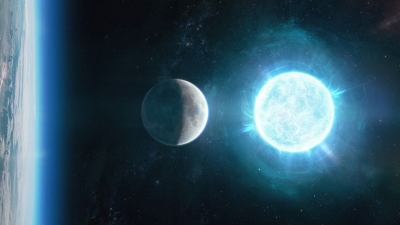
The white dwarf consists of an exotic stew of helium, carbon, and oxygen nuclei swimming in a sea of highly energetic electrons. The combined pressure of the electrons holds up the white dwarf, preventing further collapse towards an even stranger entity like a neutron star or black hole.
The white dwarf now has before it a long, quiet future. As the trapped heat trickles out, it slowly cools and dims. Eventually it will become an inert lump of carbon and oxygen floating invisibly in space: a black dwarf. But the universe isn’t old enough for any black dwarfs to have formed. The first white dwarfs born in the earliest generations of stars are still, 14 billion years later, cooling off. The coolest white dwarfs we know of, with temperature around 4,000 degrees Celsius (7,000 degrees Fahrenheit), may also be some of the oldest relics in the cosmos.
But not all white dwarfs go quietly into the night. White dwarfs that orbit other stars lead to highly explosive phenomena. The white dwarf starts things off by siphoning gas off its companion. Hydrogen is transferred across a gaseous bridge and spilled onto the white dwarf’s surface. As the hydrogen accumulates, its temperature and density reach a flash point where the entire shell of newly acquired fuel violently fuses releasing a tremendous amount of energy. This flash, called a nova, causes the white dwarf to briefly flare with the brilliance of 50,000 suns and then slowly fade back into obscurity.
White dwarfs – the cores left behind after a star has exhausted its fuel supply – are sprinkled throughout every galaxy. Like a stellar graveyard, they are the tombstones of nearly every star that lived and died. Once the sites of stellar furnaces where new atoms were forged, these ancient stars have been repurposed as an astronomer’s tool that have upended our understanding of the evolution of the universe.
Credit : Earth Sky
Picture Credit : Google




